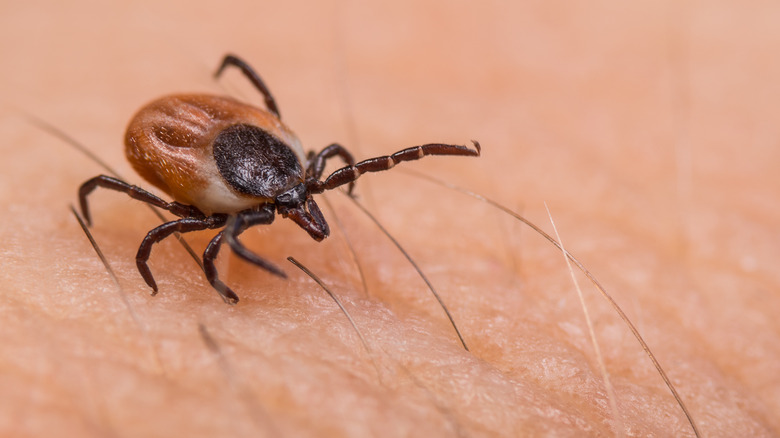How To Properly Remove A Tick
If you've discovered a tick latched onto your skin, time is of the essence. As Richard S. Ostfeld, PhD, Distinguished Senior Scientist at the Cary Institute of Ecosystem Studies, told Outdoor Guide, "The most important consideration in deciding how to remove a tick is time. Acting quickly (without panicking!) is imperative." The longer a tick remains attached, the higher the chance it will transmit harmful pathogens, including bacteria responsible for Lyme disease. "Folk remedies such as burning or smothering an attached tick with petroleum jelly should be avoided," Ostfeld also warns.
Ticks feed by anchoring their sharp, barbed mouthparts into your skin using a specialized feeding tube called a hypostome. "The hypostome has microscopic backward-pointing barbs, and the tick also secretes a cement-like substance to anchor the mouthparts in place," explains Ostfeld. This anatomy makes it challenging to remove a tick, especially when incorrect methods like twisting or pulling with bare hands are used.
As a tick feeds, your body reacts to the intrusion. You may experience local irritation, and if the tick carries disease, more serious symptoms like fever, joint pain, or fatigue may develop. Tick bites are notorious for transmitting dangerous diseases, making it all the more vital to remove the tick as soon as possible. If you're going on a hike or spending time in nature, following precautions like wearing long sleeves and using insect repellents can help prevent bites in the first place.
The right way to safely remove a tick
As Ostfeld explains, removing a tick doesn't require fancy tools. "The best way to remove the tick is to grasp it with a fine-tipped tweezer or forceps as close to the skin as possible and pull firmly." Precision is essential when dealing with ticks. Avoid twisting or using your fingers for removal. Using specialized tools like the Tick Twister isn't necessary; Ostfeld states, "I am unaware of any evidence that specialized devices marketed for removing ticks are more effective than simple fine-tipped tweezers."
Once the tick has been removed, you might notice dark remnants at the bite site. "After removal of the tick, small, dark bits might sometimes be seen at the site of the tick bite. These bits might be pieces of the tick's mouthparts that were left behind," Ostfeld tells Outdoor Guide. To reduce the risk of infection, applying a topical antibiotic cream or ointment to the area is recommended. Keeping the bite clean is crucial to avoiding skin infections, especially in cases where the tick's mouthparts remain in the skin.
For future reference, it's a good idea to save the tick after removal. "If the removed tick is intact, it may be prudent to place it in a Ziploc-type bag or to tape it (with transparent tape) to a white card," says Ostfeld. This simple precaution allows healthcare providers to identify the species if you develop symptoms of tick-borne diseases later. If you're heading outdoors where ticks are common, taking preventive measures is essential to avoid bites.

